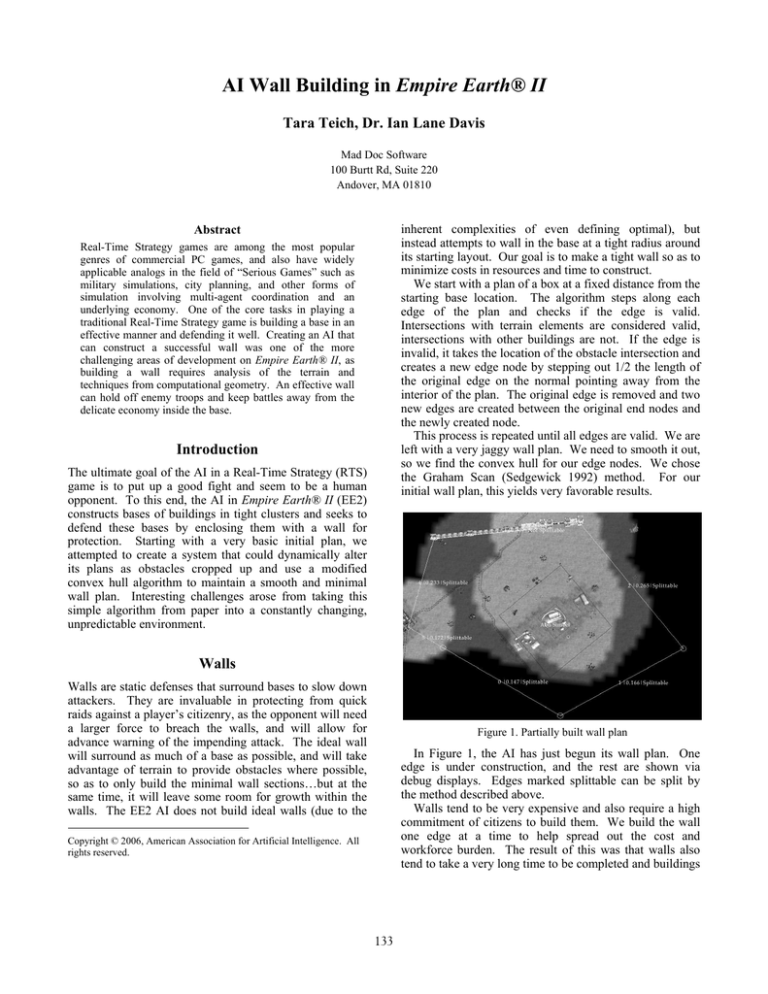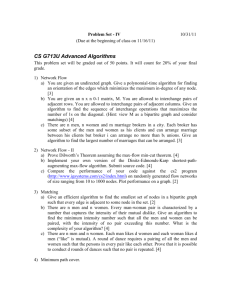
AI Wall Building in Empire Earth® II
Tara Teich, Dr. Ian Lane Davis
Mad Doc Software
100 Burtt Rd, Suite 220
Andover, MA 01810
inherent complexities of even defining optimal), but
instead attempts to wall in the base at a tight radius around
its starting layout. Our goal is to make a tight wall so as to
minimize costs in resources and time to construct.
We start with a plan of a box at a fixed distance from the
starting base location. The algorithm steps along each
edge of the plan and checks if the edge is valid.
Intersections with terrain elements are considered valid,
intersections with other buildings are not. If the edge is
invalid, it takes the location of the obstacle intersection and
creates a new edge node by stepping out 1/2 the length of
the original edge on the normal pointing away from the
interior of the plan. The original edge is removed and two
new edges are created between the original end nodes and
the newly created node.
This process is repeated until all edges are valid. We are
left with a very jaggy wall plan. We need to smooth it out,
so we find the convex hull for our edge nodes. We chose
the Graham Scan (Sedgewick 1992) method. For our
initial wall plan, this yields very favorable results.
Abstract
Real-Time Strategy games are among the most popular
genres of commercial PC games, and also have widely
applicable analogs in the field of “Serious Games” such as
military simulations, city planning, and other forms of
simulation involving multi-agent coordination and an
underlying economy. One of the core tasks in playing a
traditional Real-Time Strategy game is building a base in an
effective manner and defending it well. Creating an AI that
can construct a successful wall was one of the more
challenging areas of development on Empire Earth® II, as
building a wall requires analysis of the terrain and
techniques from computational geometry. An effective wall
can hold off enemy troops and keep battles away from the
delicate economy inside the base.
Introduction
The ultimate goal of the AI in a Real-Time Strategy (RTS)
game is to put up a good fight and seem to be a human
opponent. To this end, the AI in Empire Earth® II (EE2)
constructs bases of buildings in tight clusters and seeks to
defend these bases by enclosing them with a wall for
protection. Starting with a very basic initial plan, we
attempted to create a system that could dynamically alter
its plans as obstacles cropped up and use a modified
convex hull algorithm to maintain a smooth and minimal
wall plan. Interesting challenges arose from taking this
simple algorithm from paper into a constantly changing,
unpredictable environment.
Walls
Walls are static defenses that surround bases to slow down
attackers. They are invaluable in protecting from quick
raids against a player’s citizenry, as the opponent will need
a larger force to breach the walls, and will allow for
advance warning of the impending attack. The ideal wall
will surround as much of a base as possible, and will take
advantage of terrain to provide obstacles where possible,
so as to only build the minimal wall sections…but at the
same time, it will leave some room for growth within the
walls. The EE2 AI does not build ideal walls (due to the
Figure 1. Partially built wall plan
In Figure 1, the AI has just begun its wall plan. One
edge is under construction, and the rest are shown via
debug displays. Edges marked splittable can be split by
the method described above.
Walls tend to be very expensive and also require a high
commitment of citizens to build them. We build the wall
one edge at a time to help spread out the cost and
workforce burden. The result of this was that walls also
tend to take a very long time to be completed and buildings
Copyright © 2006, American Association for Artificial Intelligence. All
rights reserved.
133
were sometimes placed smack in the midst of a planned
wall edge.
Fortunately, we can use our smoothing algorithm to
compensate for this. Before building an edge, the wall
builder checks its validity. If it is no longer valid, it will
repeat the process it used at creation, splitting the edge and
ultimately re-smoothing the graph. This results in vast
complications as we can have a partially built wall. This
means that the convex hull algorithm cannot treat all nodes
equally, as some of them are not removable.
The first part of the Graham Scan algorithm involves
finding the bottom most node and then sorting all nodes by
their rotation from that point. Because some edges are
already built, we need to fix up the order after the sort is
complete. We loop through all edges and for each edge
that is already built we make sure that the tail node
immediately succeeds the head node. This is further
complicated by the possibility that multiple adjacent edges
are already completed, so nodes must be moved to ensure
that all connections are maintained. Following is the
algorithm for the Graham Scan with our additions in bold.
1. Find bottom most edge node
2. Sort all nodes at their angle from
this minimum point
3. Loop through all edges in wall plan
4. If edge is already built, move the
two nodes of the edge adjacent in the
sorted list
5. Loop through sorted node list
6. Look at nodes in groups of three
7. while the angle between these nodes
is counter-clockwise and the middle
node is not on a started edge drop
the middle node and use last node and
two nodes before the middle as the
group of three
Figure 2. Wall plan with some built segments and a road
intersecting the plan.
road and wall are nearly parallel. We needed to add a
special case to deal with this intersection.
The only allowable intersections between roads and
walls are at a perpendicular, which causes the wall system
to automatically insert a gate. The goal of the wall planner
therefore becomes to insert a segment perpendicular to the
road and connect the ends of the segment to the existing
wall plan. In most cases, this works well.
Figures 2 and 3 show the wall from Figure 1 in a further
state of development. A road is intruding on the leftmost
portion of the plan, and the edges connecting to this invalid
edge are both already constructed. The AI manages to
successfully create a gate edge, visible in the upper left
section of the completed wall in Figure 3. Unfortunately,
this wall has two problems: a node in the lower right is
partially overlapping a building, and the plan doesn’t
handle the small forest very well. The node inside the
building cannot be moved because that edge is already
constructed. Other than this problem area, the wall is
successful - it almost completely encloses the base.
We do not want to remove any nodes that are part of an
existing edge. Our AI never destroys wall segments it has
already built as this is both a waste of money and would
make a player who observes the behavior think the AI was
not being smart (in commercial games these perceptions
are significant). Unfortunately this yields some nonoptimal wall layouts when new obstacles make existing
edges lie on the interior of the convex hull.
Roads pose a particular challenge to wall plans.
Because a road is a continuous obstacle, the usual solution
of stepping away from the obstacle doesn't work unless the
134
Conclusions
AI wall building is a challenging problem that has received
very little industry attention. Many top-tier RTS titles
avoid the problem entirely. We examined recent titles such
as Age of Empires® III and never saw the AI players
attempt to construct a wall. Ultimately, our goal is to
create a challenging opponent for the human player that
enables an enjoyable gameplay experience and appears as
human as possible. Building a wall is a complex problem
of computational geometry that is only a small part of
contributing to this overall goal, yet takes a significant
contribution from the developer. As developers place
more attention on the AI in general, more focus will be
placed on walls in particular. Another current title, The
Battle for Middle-Earth™ II does tackle the challenge.
The first Empire Earth® AI built walls as well, though it
simply boxed in its entire corner of the map with no
consideration of minimizing wall cost. Future developers
entering the arena will benefit from understanding the
techniques presented here, and an expansion of this
geometric algorithm will create a better, more believable
AI.
Figure 3. Complete wall with inserted gate
Close examination of the left hand side of Figure 3
reveals the problem. The lower left area is densely packed
with buildings and terrain elements such as trees. Given
our requirement that the AI never destroy an existing
structure, there is no clear solution to this situation.
Future Work
The best results in crafting RTS AI usually come from
studying what human players do and attempting to mimic
their behavior. Our initial algorithm design was flawed, as
it was not derived from a system that a human would use.
Human players do a high level terrain analysis and lay out
a wall plan that encompasses more territory than they
currently control so as to provide room to grow. The
Empire Earth® II AI has no notion of where things will
go, only where they are. Humans will also identify
permanent terrain features that make effect barriers and
incorporate these into their wall plans. The EE2 AI makes
little use of terrain features to minimize the amount of wall
to build, and doesn't necessarily realize when a wall is
spread over non-contiguous areas, such as when the wall
crosses a river. A more predictive system could avoid
some of these pitfalls, though the predications can be
complex, especially when multiple players are involved but
even within one team’s AI as you cannot be sure when the
overall plan will change as the current battle conditions
change.
In future work on wall building, we would like to start
with a better initial wall plan. Beginning with an analysis
phase that could identify terrain features to incorporate into
the wall plan would yield walls that require fewer edges
and therefore cost fewer resources and can be completed
more rapidly. We could then apply the techniques
described here to handle obstacles in planned edges as well
as a modification of the smoothing algorithm to treat
terrain features as non-removable edges in the graph and
ensure the entire plan remains as close to a convex form as
possible.
References
Davis, I. L. 1999. Strategies for Strategy Game AI. AAAI
1999 Spring Symposium on AI & Computer Games
Proceedings. March, 1999
Davis, I. L. 2000. Warp Speed: Path Planning for Star
Trek: Armada. AAAI 2000 Spring Symposium on
Interactive Entertainment and AI Proceedings. March,
2000.
Sedgewick, R. 1992. Algorithms in C++. Reading, Mass.:
Addison-Wesley.
Preparata, F. P. and Shamos, M. I. 1985. Computational
Geometry: An Introduction. Springer-Verlag
135





